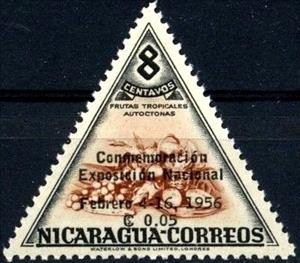Stamp: Surcharged (Nicaragua 1956)
Surcharged (Nicaragua 1956)
04 February (Nicaragua ) within release National Exhibition goes into circulation Stamp Surcharged face value 0.05 Nicaraguan córdoba
| Stamp Surcharged in catalogues | |
|---|---|
| Michel: | Mi:NI 1103 |
| Stamp Number: | Sn:NI 769 |
| Yvert et Tellier: | Yt:NI 788 |
Stamp is square format.
Also in the issue National Exhibition:
- Stamp - Surcharged face value 0.05;
- Stamp - Surcharged face value 0.05;
- Stamp - Surcharged face value 0.05;
- Stamp - Surcharged face value 0.15;
- Stamp - Surcharged face value 0.15;
- Stamp - Surcharged face value 0.15;
- Stamp - Surcharged in Green or Black face value 0.30;
- Stamp - Surcharged in Green or Black face value 0.30;
- Stamp - Surcharged in Green or Black face value 0.30;
- Stamp - Surcharged in Green or Black face value 2;
Stamp Surcharged it reflects the thematic directions:
An exposition, in the most general sense, is an organized presentation and display of a selection of items. In practice, exhibitions usually occur within museums, galleries and exhibition halls, and World's fairs. Exhibitions can include many things such as art in both major museums and smaller galleries, interpretive exhibitions, natural history museums and history museums, and also varieties such as more commercially focused exhibitions and trade fairs.
In botany, a fruit is the seed-bearing structure in flowering plants (also known as angiosperms) formed from the ovary after flowering. Fruits are the means by which angiosperms disseminate seeds. Edible fruits, in particular, have propagated with the movements of humans and animals in a symbiotic relationship as a means for seed dispersal and nutrition; in fact, humans and many animals have become dependent on fruits as a source of food. Accordingly, fruits account for a substantial fraction of the world's agricultural output, and some (such as the apple and the pomegranate) have acquired extensive cultural and symbolic meanings. In common language usage, "fruit" normally means the fleshy seed-associated structures of a plant that are sweet or sour, and edible in the raw state, such as apples, bananas, grapes, lemons, oranges, and strawberries. On the other hand, in botanical usage, "fruit" includes many structures that are not commonly called "fruits", such as bean pods, corn kernels, tomatoes, and wheat grains. The section of a fungus that produces spores is also called a fruiting body.
The Kionga Triangle (German: Kionga-Dreieck, Portuguese: Triângulo de Quionga) was a small region of German East Africa situated at the mouth of the Ruvuma River. The Ruvuma served as the border between the German colony and Portuguese Mozambique, and the Kionga Triangle was the only section of German East Africa south of the river. Its principal settlement was Kionga (now Quionga ) which had a population of 4,000 in 1910. It became a German possession in 1894 but came under Portuguese control in April 1916 during World War I. The post-war Treaty of Versailles reaffirmed that the river was the border between Tanganyika, then under British control, and Portuguese Mozambique. The triangle was the only territory that the treaty awarded to Portugal.


